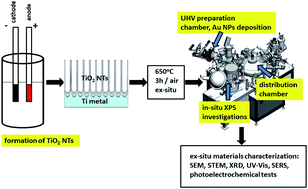Materials characterization of TiO2 nanotubes decorated by Au nanoparticles for photoelectrochemical applications
Abstract
The structural and chemical modification of TiO2 nanotubes (NTs) by the deposition of a well-controlled Au deposit was investigated using a combination of X-ray photoelectron spectroscopy (XPS), scanning electron microscopy (SEM), Scanning Transmission Electron Microscopy (STEM), Raman measurements, UV-Vis spectroscopy and photoelectrochemical investigations. The fabrication of the materials focused on two important factors: the deposition of Au nanoparticles (NPs) in UHV (ultra high vacuum) conditions (1–2 × 10−8 mbar) on TiO2 nanotubes (NTs) having a diameter of ∼110 nm, and modifying the electronic interaction between the TiO2 NTs and Au nanoparticles (NPs) with an average diameter of about 5 nm through the synergistic effects of SMSI (Strong Metal Support Interaction) and LSPR (Local Surface Plasmon Resonance). Due to the formation of unique places in the form of “hot spots”, the proposed nanostructures proved to be photoactive in the UV-Vis range, where a characteristic gold plasmonic peak was observed at a wavelength of 580 nm. The photocurrent density of Au deposited TiO2 NTs annealed at 650 °C was found to be much greater (14.7 μA cm−2) than the corresponding value (∼0.2 μA cm−2) for nanotubes in the as-received state. The IPCE (incident photon current efficiency) spectral evidence also indicates an enhancement of the photoconversion of TiO2 NTs due to Au NP deposition without any significant change in the band gap energy of the titanium dioxide (Eg ∼3.0 eV). This suggests that a plasmon-induced resonant energy transfer (PRET) was the dominant effect responsible for the photoactivity of the obtained materials.



 Please wait while we load your content...
Please wait while we load your content...